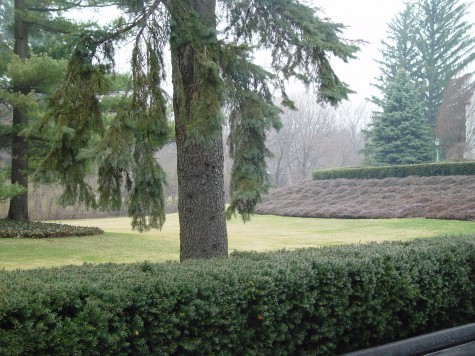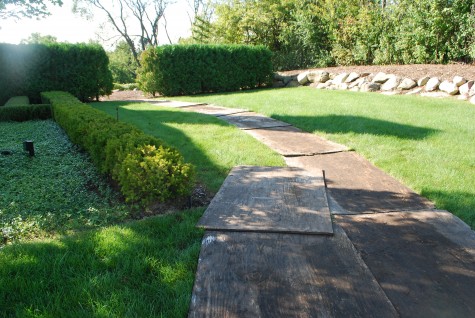I have been painting the border of painted concrete floor in the shop the past few days; the word “border” is on my mind. The language of the garden-a special language that crosses over national boundaries and may span centuries. To whit-a verge refers to an edge in the garden, deeply cut with an edging spade. A verge also refers to the shoulder of a road. This is primarily a British term. I greatly admire British gardens and gardeners; I equally like their use of language. When I am edging a bed, the idea that I am creating a verge lends great dignity and creates excitement about what amounts to plain hard work. I know how to amuse myself, when I am working. A well cut verge is not so unlike a precipice that you could fall into, and break an ankle. A passionately cut and serious edge on a bed. Sharp clean edges make for a beautiful presentation. I fancy the grass border pictured above on this walk qualifies as a shoulder of a modest road-a grass verge. The grass also forms a border for a luxuriant bed of variegated Krossa Regal hosta. This plant is so textural and lyrical in appearance, a quiet setting would seem to display it to best advantage. In this case, a border of grass.
 This hedge of limelight hydrangea, bordering a hedge of lilac, itself bordered by grass, borders a road. A border? A border is a line or a mass that visually indicates a boundary. This border of three plants in three heights forms a boundary. It screens a private garden from a public thoroughfare. This landscape border is on the verge of spilling over onto the roadway. OK, I have a very active imagination.
This hedge of limelight hydrangea, bordering a hedge of lilac, itself bordered by grass, borders a road. A border? A border is a line or a mass that visually indicates a boundary. This border of three plants in three heights forms a boundary. It screens a private garden from a public thoroughfare. This landscape border is on the verge of spilling over onto the roadway. OK, I have a very active imagination.
 This boxwood, punctuated by crabapple standards creates a border which separates the public presentation of the landscape from private garden. There is no reason why the landscape which faces the street need be an entirely public landscape. This border creates a boundary. Should you drive by, you are visually privy to what exists planted on the streetside of the boxwood. Should you be an invited guest, you are also privy to what is planted on the house side of the border. I like the idea of making friends especially welcome with a landscape experience all their own.
This boxwood, punctuated by crabapple standards creates a border which separates the public presentation of the landscape from private garden. There is no reason why the landscape which faces the street need be an entirely public landscape. This border creates a boundary. Should you drive by, you are visually privy to what exists planted on the streetside of the boxwood. Should you be an invited guest, you are also privy to what is planted on the house side of the border. I like the idea of making friends especially welcome with a landscape experience all their own.
 My fountain brings me great pleasure. A concrete affair faced in Valders stone, it needs a border that separates it from the grass. Grass clippings in the pool-not good. A border of herniaria replicates the look of the grass, but needs no mowing. The Valders stone is a border which protects the herniaria from the chlorine in the fountain. Some borders are about visual definition; some borders are about protection.
My fountain brings me great pleasure. A concrete affair faced in Valders stone, it needs a border that separates it from the grass. Grass clippings in the pool-not good. A border of herniaria replicates the look of the grass, but needs no mowing. The Valders stone is a border which protects the herniaria from the chlorine in the fountain. Some borders are about visual definition; some borders are about protection.
 This formally clipped yew hedge is a border clearly delineating this driveway. This is a dicey move in our zone; road salt can severely damage yews. Should you be thinking of bordering your drive with an evergreen, look at your salt habit. The junipers planted on this slope, so beautiful in their winter color, a spectacularly generous border bewtwen the lawn plane, and the driveway plane. This simple border tells you everything you need to know about the elevation of the house.
This formally clipped yew hedge is a border clearly delineating this driveway. This is a dicey move in our zone; road salt can severely damage yews. Should you be thinking of bordering your drive with an evergreen, look at your salt habit. The junipers planted on this slope, so beautiful in their winter color, a spectacularly generous border bewtwen the lawn plane, and the driveway plane. This simple border tells you everything you need to know about the elevation of the house.
 Perennial borders-no one does them better than the Brits. My zone 4to5 makes me reluctant to invest too much in a perennial border. I had lots of space here-so half of it went to a hydrangea border. The hydrangeas, rugged and dependable. Given the design of the border, the lawn reads as a road, a generous path to somewhere. In this case, a pergola. Yet to come, a focal point at the end of this grass verge which would encourage travel. I think one of the most important elements of landscape design involves how to encourage people to travel through, and experience that landscape.
Perennial borders-no one does them better than the Brits. My zone 4to5 makes me reluctant to invest too much in a perennial border. I had lots of space here-so half of it went to a hydrangea border. The hydrangeas, rugged and dependable. Given the design of the border, the lawn reads as a road, a generous path to somewhere. In this case, a pergola. Yet to come, a focal point at the end of this grass verge which would encourage travel. I think one of the most important elements of landscape design involves how to encourage people to travel through, and experience that landscape.

This low and so beautifully constructed wall is a border, a retaining wall, between one level and the next. A change of grade asks for a boundary. A change of grade requires steps. I like to signal that one level is ending, and another level is to come. I like moves in a landscape that are clear and easy to read. Clear and confident moves are beautiful to my eye. A crisp verge-how I love this.










